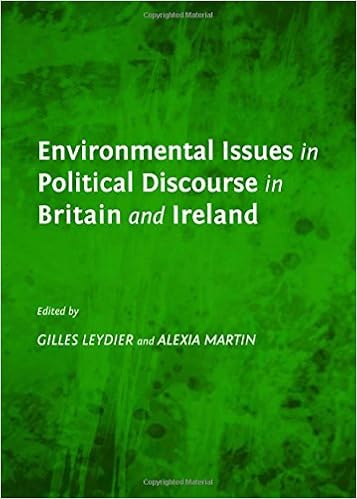New PDF release: Environmental Histories of the Cold War (Publications of the

By J. R. McNeill (editor), Corinna R. Unger (editor)
ISBN-10: 0511730381
ISBN-13: 9780511730382
ISBN-10: 0521762448
ISBN-13: 9780521762441
Environmental Histories of the chilly conflict explores the hyperlinks among the chilly warfare and the worldwide setting, starting from the environmental affects of nuclear guns to the political repercussions of environmentalism. Environmental swap sped up sharply throughout the chilly struggle years, and so did environmentalism as either a favored flow and a systematic preoccupation. such a lot chilly struggle background totally overlooks this upward push of environmentalism and the crescendo of environmental switch. those old matters weren't purely simultaneous but additionally associated jointly in methods either easy and astounding. The individuals to this booklet current those attached matters as an international phenomenon, with chapters bearing on China, the USSR, Europe, North the United States, Oceania, and in other places. The position of specialists as brokers and advocates of utilizing the surroundings as a weapon within the chilly conflict or, contrastingly, of forestalling environmental harm due to chilly struggle politics is additionally given vast cognizance.
Read or Download Environmental Histories of the Cold War (Publications of the German Historical Institute) PDF
Best environmental books
Environmental dangers linked to large-scale marine finfish cage aquaculture have ended in claims that the long term sustainability of the is doubtful. tools and versions presently used to degree close to and far-field environmental results of finfish mariculture and to evaluate their implications for administration are offered in 20 chapters prepared in 4 sections (Eutrophication, Sedimentation and Benthic affects, alterations in Trophic constitution and serve as, and handling Environmental Risks).
Development reputation and different chemometrical concepts are vital instruments in analyzing environmental facts. This quantity offers authoritatively state of the art systems for measuring and dealing with environmental information. The chapters are written by means of top specialists.
Environmental Issues in Political Discourse in Britain and by Gilles Leydier, Alexia Martin PDF
This publication examines the political reaction to present environmental matters within the context of the British Isles. How have the problems been assimilated through political events? which of them were given precedence? who're the most actors and what's the function of ecologists? solutions to questions akin to those are supplied during this collective paintings, not just via important insights into the theories and ideas present in political ecology, but in addition with particular exam of current political debates, equivalent to the Liberal Democrats' stance, the query of nuclear power or the salient factor of weather swap.
Download PDF by Michael E. Meadows, Jiun-Chuan Lin (eds.): Geomorphology and Society
This publication bargains with the connection among geomorphology and society. This subject has had relatively scant remedy within the literature other than to a point lower than the label “applied geomorphology”. during this textual content the authors goal to compile conceptual matters and case experiences of ways geomorphology impacts society and, certainly, how society is in flip motivated via geomorphology.
- Public Participation and Better Environmental Decisions: The Promise and Limits of Participatory Processes for the Quality of Environmentally Related Decision-making
- Adaption of Microbial Life to Environmental Extremes: Novel Research Results and Application
- geoENV II — Geostatistics for Environmental Applications: Proceedings of the Second European Conference on Geostatistics for Environmental Applications held in Valencia, Spain, November 18–20, 1998
- Socioeconomic and Environmental Implications of Agricultural Residue Burning: A Case Study of Punjab, India
Additional resources for Environmental Histories of the Cold War (Publications of the German Historical Institute)
Sample text
Before railroads and roads were built, planners intended to use rivers for transport during the three months out of the year they were not icebound. They focused on building icebreakers. By the mid-1930s, they had established a chain of fifty-seven radio stations along the coast that operated year-round and provided meteorological and other information. Ice-watch airplanes also assisted the icebreakers. 28 The authorities ordered prison labor to harvest Siberian timber as well. One gulag camp, Igarka, 650 kilometers inland on the Enesei River, focused on forest resources.
24 Resource waste was endemic. The war experience had forced Soviet leaders and citizens to embrace wasteful industrial practices, to ignore resource scarcities, and to denigrate the worth of both humans and nature. This 20 K. Klimenko, Ural’skoi promyshlennoi raion (Moscow, 1945), 26, 30, 37; and V. Gusev, “Kak kirovtsy delali tanki v Cheliabinske,” Znamia, August 1974, 141–6. 21 A. F. Zhdanov, Berezniki – Gorod ural’skikh khimikov (Molotovsk, 1956), 22–33. 22 Klimenko, Ural’skoi, 29. 23 Shcherbo, “Razvitie otechestvennoi stroitel’noi nauki,” 122–36.
6 The primacy of the politics of production paradoxically created an economy that was very inefficient; the rational plan was irrational. Given the resulting industrial style and the mind-set of party officials, managers, and workers, it was difficult, if not impossible, to ensure efficient use of resources. Concerns about the costs of industrial production for humans and nature alike wafted into the smoky sky, flowed into the murky rivers, and piled up in haphazard dumps proximate to home, field, and factory.
Environmental Histories of the Cold War (Publications of the German Historical Institute) by J. R. McNeill (editor), Corinna R. Unger (editor)
by Richard
4.2



